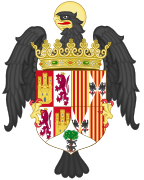Ferdinand II of Aragon
| Ferdinand II | |
|---|---|
León | |
| Reign | 15 January 1475 – 26 November 1504 |
| Predecessor | Isabella I |
| Successor | Joanna |
| Alongside | Isabella I |
| Born | 10 March 1452 Sos, Aragon |
| Died | 23 January 1516 (aged 63) Madrigalejo, Extremadura |
| Burial | |
| Spouses | |
| Issue more... | |
Roman Catholicism | |
| Signature |  |
Ferdinand II
The Crown of Aragon that Ferdinand inherited in 1479 included the kingdoms of Aragon, Valencia, Majorca, Sardinia, and Sicily, as well as the Principality of Catalonia. His marriage to Isabella is regarded as the "cornerstone in the foundation of the Spanish monarchy".[2] They played a major role in the European colonization of the Americas, sponsoring the first voyage of Christopher Columbus in 1492. That year the couple defeated Granada, the last Muslim state in Western Europe, thus completing the centuries-long Reconquista.
Following Isabella's death in 1504, the couple's daughter
Early life
Ferdinand was born on 10 March 1452, in the town of Sos del Rey Católico, Kingdom of Aragon, as the son of John II of Aragon (whose family was a cadet branch of the House of Trastámara) by his second wife, Juana Enríquez.[3]
Marriage and accession
Ferdinand married

The first years of Ferdinand and Isabella's joint rule saw the Spanish conquest of the Emirate of Granada, the last Islamic al-Andalus entity on the Iberian peninsula, completed in 1492.[4][7]
The completion of the
In 1494 the Treaty of Tordesillas divided the entire world beyond Europe between Portugal and Castile (Spain) for conquest and dominion purposes – by a north–south line drawn down the Atlantic Ocean.
Forced conversions
Ferdinand abrogated a section of the 1491
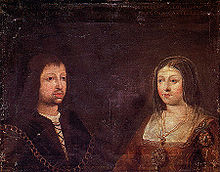
The latter part of Ferdinand's life was largely taken up with disputes with successive kings of
The King of France complains that I have twice deceived him. He lies, the fool; I have deceived him ten times and more.
— Ferdinand the Catholic[10]
Some time before 1502 Andreas Palaiologos, the last exiled claimant to the Byzantine throne of his house, sold his titles and royal and imperial rights to Ferdinand. Those, however, had never been made use of, due to the doubtful nature of the deal.[11]
After Isabella
Isabella made her will on 12 October 1504, in advance of her 26 November 1504 death. In it she spelled out the succession to the Crown of Castile, leaving it to Joanna and then to Joanna's son Charles. Isabella was dubious of Joanna's ability to rule and was not confident of Joanna's husband Archduke Philip. Ferdinand moved quickly after his wife's death to continue his role in Castile. On the day of his wife's death, he formally renounced his title as King of Castile and instead became governor (gobernador) of the kingdom, as a way to become regent. Philip deemed his wife sane and fit to rule. A compromise was forged between Philip and Ferdinand, which gave Ferdinand a continued role in Castile.[13] Ferdinand had served as Joanna's regent during her absence in the Netherlands, ruled by her husband Archduke Philip. Ferdinand attempted to retain the regency permanently, but was rebuffed by the Castilian nobility and replaced with Joanna's husband.
In the Treaty of Villafáfila of 1506, Ferdinand renounced not only the government of Castile in favor of Philip but also the lordship of the Indies, withholding half of the income of the "kingdoms of the Indies".[14] Joanna and Philip immediately added to their titles the kingdoms of Indies, Islands and Mainland of the Ocean Sea. But the Treaty of Villafáfila did not hold for long because of the death of Philip; Ferdinand returned as regent of Castile and as "lord of the Indies".[15]
The widowed Ferdinand made an alliance with France in July 1505 and married
Ferdinand had no legal position in Castile, with the cortes of Toro recognizing Joanna and her children as heirs and Ferdinand left Castile in July 1506. After his son-in-law Philip's untimely death in September 1506, Castile was in crisis. Joanna was allegedly mentally unstable, and Joanna's and Philip's son, Charles, the future Emperor
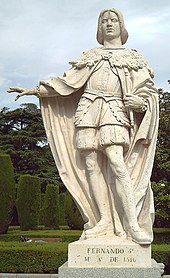
By 1508 Ferdinand had triumphed and war resumed in Italy, this time against the Republic of Venice, in which all the other powers with interests on the Italian peninsula, including Louis XII, Ferdinand II, Maximilian, and Pope Julius II joined together in the League of Cambrai. Although the French were victorious against Venice at the Battle of Agnadello, the League of Cambrai soon fell apart, as both the Pope and Ferdinand II became suspicious of French intentions. Instead, the 'Holy League' was formed, in which now all the powers joined together against Louis XII and France.
In November 1511 Ferdinand and his son-in-law King
Ferdinand II died on 23 January 1516 in Madrigalejo, Extremadura, Kingdom of Castile and Leon. He is entombed at Capilla Real, Granada. His wife Isabella, daughter Joanna, and son-in-law Philip rest beside him there.
Legacy and succession
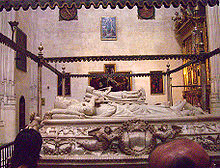
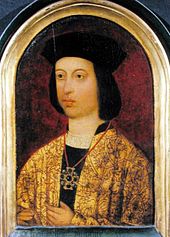
Ferdinand and Isabella established a highly effective sovereignty under equal terms. They utilised a prenuptial agreement to lay down their terms. During their reign they supported each other effectively in accordance to his joint motto of equality: "Tanto monta [or monta tanto], Isabel como Fernando" ("They amount to the same, Isabel and Ferdinand"). Isabella and Ferdinand's achievements were remarkable: Spain was united, or at least more united than it ever had been; the crown power was centralised, at least in name; the reconquista was successfully concluded; the groundwork for the most dominant military machine of the next century and a half was laid; a legal framework was created; the church was reformed. Even without the benefit of the American expansion, Spain would have been a major European power. Columbus' discovery set the country on the course for the first modern world power.
During the reign of Ferdinand and Isabella, Spain pursued
In 1502, the members of the Aragonese Cortes gathered in
Ferdinand's grandson and successor Charles, was to inherit not only the Spanish lands of his maternal grandparents, but the Austrian and Burgundian lands of his paternal family, which would make his heirs the most powerful rulers on the continent and, with the discoveries and conquests in the Americas and elsewhere, of the first truly global empire.
Children
With his wife Isabella I the Catholic (whom he married 19 October 1469), King Ferdinand had seven children:
- Afonso, Prince of Portugal, then after his death married his uncle Prince Manuel, the future King Manuel I of Portugal. She died in childbirth delivering her son Miguel da Paz, Crown Prince of both Portugal and Spain who, in turn, died in infancy.
- A son miscarried on 31 May 1475 in Cebreros
- John (1478–1497), Prince of Asturias (1478–1497). He married Margaret of Austria (daughter of Emperor Maximilian I). He died of tuberculosis and his posthumous child with Margaret was stillborn.
- Charles I of Spain (also known as Charles V as Holy Roman Emperor). Ferdinand made her out to be mentally unstable and she was incarcerated by him, and then by her son, in Tordesillas for over 50 years. Her grandson, Philip II of Spain, was crowned in 1556.
- Henry I of Portugal.
- A stillborn daughter, twin of Maria. Born 1 July 1482 at dawn.
- Catalina (1485–1536), later known as Catherine of Aragon, queen of England. She married first Arthur, Prince of Wales, son of and heir to King Henry VII of England and, after Prince Arthur's death, she married his brother Henry, Duke of York, who also became Prince of Wales and then King Henry VIII. She thus became Queen of England and was the mother of Queen Mary I.
With his second wife,
- John, Prince of Girona, who died hours after being born on 3 May 1509.
He also left several illegitimate children, two of them were born before his marriage to Isabella:
With
- Alonso de Aragón (1469–1520). Archbishop of Zaragoza and Viceroy of Aragon.
With Joana Nicolaua:
- Juana de Aragón (1469 – bef. 1522). She married Bernardino Fernández de Velasco, 1st Duke of Frías.
With Toda de Larrea:
- María Esperanza de Aragón (? – 1543). Abbess of Santa María la Real de Las Huelgas.
With Beatriz Pereira:
- (? – 1550). Nun at Madrigal de las Altas Torres.
Heraldry
| Heraldry of Ferdinand of Aragon |
|---|
|
Monarch of the Crown of Castille (with Isabella I)
DescriptionThe Arms quarter the arms of Castile and León with the arms of Aragon and Aragonese Sicily, the last combining the arms of Aragon with the black eagle of the Hohenstaufen of Sicily.[24] Sovereign of Aragon
Lord of Biscay |
Depiction in film and television
Films
| Year | Film | Director(s) | Actor |
|---|---|---|---|
| 1951 | Hare We Go | Robert McKimson | Mel Blanc |
| 1976 | La espada negra | Francisco Rovira Beleta | Juan Ribó |
| 1985 | Christopher Columbus | Alberto Lattuada | Nicol Williamson |
| 1992 | Christopher Columbus: The Discovery | John Glen | Tom Selleck |
| 1992 | 1492: Conquest of Paradise | Ridley Scott | Fernando García Rimada |
| 1992 | Carry On Columbus | Gerald Thomas | Leslie Phillips |
| 2001 | Juana la Loca | Vicente Aranda | Héctor Colomé |
| 2016 | Assassin's Creed |
Justin Kurzel | Thomas Camilleri |
TV series
| Year | Series | Channel |
|---|---|---|
| 1980 | Shaheen(Based on Naseem Hijazi Novel) | PTV |
| 1991 | Réquiem por Granada | TVE |
| 2004 | Memoria de España | TVE |
| 2011 | Muhteşem Yüzyıl | Show TV |
| 2012 | Isabel, | TVE |
| 2014 | Borgia (TV series) | Canal+ |
See also
- Catholic Monarchs
- Spanish Empire
Explanatory notes
References
- ^ Aram, "Monarchs of Spain", p. 725.
- ^ Bethany Aram, "Monarchs of Spain" in Iberia and the Americas, vol. 2, p. 725. Santa Barbara: ABC Clio 2006.
- ^ Edwards, John. The Spain of the Catholic Monarchs 1474–1520. Blackwell Publishers Inc, 2000, p. xiii
- ^ a b c Palos, Joan-Lluís (28 March 2019). "To seize power in Spain, Queen Isabella had to play it smart: Bold, strategic, and steady, Isabella of Castile navigated an unlikely rise to the throne and ushered in a golden age for Spain". National Geographic History Magazine. Archived from the original on 30 March 2019. Retrieved 20 April 2019.
- ^ Edwards, John. The Spain of the Catholic Monarchs 1474–1520. Blackwell Publishers Inc, 2000, pp. 1–37
- ^ Edwards, John. The Spain of the Catholic Monarchs 1474–1520. Blackwell Publishers Inc, 2000, pp. 38–39
- ISBN 0-19-280236-4.
- ^ Michael C. Thomsett, The Inquisition: A History (Jefferson, NC: McFarland and Company, Inc., 2010), 158.
- ISBN 0-19-509026-8
- ISBN 0-8061-2934-4, p. 474.
- ^ Norwich, John Julius, Byzantium: The Decline and Fall, p. 446
- ^ Guillermo Fatás y Guillermo Redondo (1995). "Blasón de Aragón" (in Spanish). Zaragoza, Diputación General de Aragón. pp. 101–102. Archived from the original on 31 January 2012.
- ^ a b Edwards, The Spain of the Catholic Monarchs, p. 288.
- ^ Memoria del Segundo Congreso Venezolano de Historia, del 18 al 23 de noviembre de 1974 (in Spanish). Academia Nacional de la Historia (Venezuela). 1975. p. 404.
- ^ Sánchez Prieto, Ana Belén (2004). La intitulación diplomática de los Reyes Católicos: un programa político y una lección de historia (PDF) (in Spanish). III Jornadas Científicas sobre Documentación en época de los Reyes Católicos. p. 296.
- ^ De Francisco Olmos, José María: Estudio documental de la moneda castellana de Carlos I fabricada en los Países Bajos (1517), Revista General de Información y Documentación 13, 133–153, 2003. URL: L. Külső hivatkozások
- ^ Edwards, The Spain of the Catholic Monarchs, pp. 288–289.
- ISBN 0-14-100703-6
- ^ Estudio documental de la moneda castellana de Carlos I fabricada en los Países Bajos (1517); José María de Francisco Olmos Archived 5 February 2012 at the Wayback Machine, Revista General de Información y Documentación 2003, vol 13, núm.2 (Universidad complutense de Madrid), p. 137
- ^ Estudio documental de la moneda castellana de Juana la Loca fabricada en los Países Bajos (1505–1506); José María de Francisco Olmos Archived 14 January 2012 at the Wayback Machine, Revista General de Información y Documentación 2002, vol 12, núm.2 (Universidad complutense de Madrid), p. 299
- ^ Estudio documental de la moneda castellana de Carlos I fabricada en los Países Bajos (1517); José María de Francisco Olmos Archived 5 February 2012 at the Wayback Machine, Revista General de Información y Documentación 2003, vol 13, núm.2 (Universidad complutense de Madrid) p. 138
- ^ Historia general de España; Modesto Lafuente (1861), pp. 51–52.
- ^ Fueros, observancias y actos de corte del Reino de Aragón; Santiago Penén y Debesa, Pascual Savall y Dronda, Miguel Clemente (1866) Archived 10 June 2008 at the Wayback Machine, p. 64 Archived 10 June 2008 at the Wayback Machine
- ^ ISBN 978-84-88833-02-0
External links
- Azcona, T. [in Spanish] (20 July 1998). "Ferdinand II, king of Spain". Encyclopædia Britannica.



![Coat of arms of Ferdinand II, in La Aljafería in Zaragoza.[24]](http://upload.wikimedia.org/wikipedia/commons/thumb/b/bf/Blas%C3%B3n_de_Fernando_II_de_Arag%C3%B3n_en_la_Aljafer%C3%ADa.jpg/133px-Blas%C3%B3n_de_Fernando_II_de_Arag%C3%B3n_en_la_Aljafer%C3%ADa.jpg)
![Common design 1479–1492[24]](http://upload.wikimedia.org/wikipedia/commons/thumb/9/96/Coat_of_Arms_of_Ferdinand_II_of_Aragon_%281479-1492%29.svg/198px-Coat_of_Arms_of_Ferdinand_II_of_Aragon_%281479-1492%29.svg.png)
![Version with supporters 1513–1516[24]](http://upload.wikimedia.org/wikipedia/commons/thumb/6/6d/Coat_of_Arms_of_Ferdinand_II_of_Aragon_with_supporters_%281513-1516%29.svg/225px-Coat_of_Arms_of_Ferdinand_II_of_Aragon_with_supporters_%281513-1516%29.svg.png)
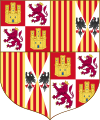

![1504–1513[24]](http://upload.wikimedia.org/wikipedia/commons/thumb/7/72/Arms_of_Ferdinand_II_of_Aragon_%281504-1513%29.svg/98px-Arms_of_Ferdinand_II_of_Aragon_%281504-1513%29.svg.png)
![1513–1516[24]](http://upload.wikimedia.org/wikipedia/commons/thumb/f/f9/Arms_of_Ferdinand_II_of_Aragon_%281513-1516%29.svg/98px-Arms_of_Ferdinand_II_of_Aragon_%281513-1516%29.svg.png)
